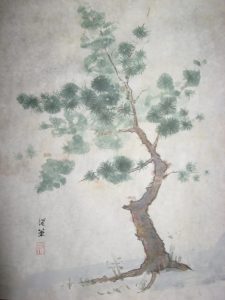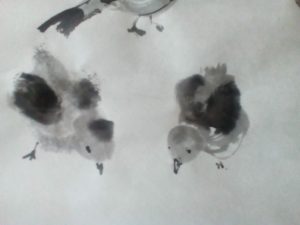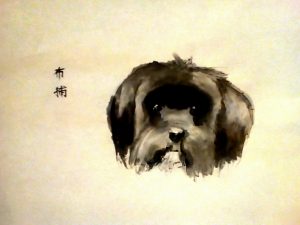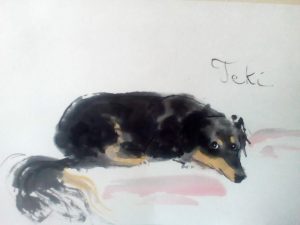Forum Replies Created
-
AuthorPosts
-
 tibiliuParticipant
tibiliuParticipantHi, Felice and a happy new year!
You are basically talking about the process caled “Chinese mounting”. It is essential to master enleast the first step of creating a mounted painting/calligraphy, i.e. what you called “reinforcement” and what is commonly refered to as “first and second backing”. Why? Because it is the only way to turn your wrinkly, buckled artwork in a superbly flat surface again. The process is simple, fascinating and very satisfying.
If you watch Henry Li’s videos and read what is up on the internet or on this forum about “Chinese mounting” you will be able to learn. You will enleast be able to back and straighten your artwork so you can have it framed.
Usually the inks resist the wet treatment if they are genuine oriental type, but if you have any doubts or want supplimentary reassurance there is a trick to make them withstand any wet treatment: gently apply whith a softbrush a soution of 1% gelatine with 0.6% alum…that is roughly 1g gelatine, 0.6g alum, 100ml water (mix cold, wait 10min, heat in bain marie). It’s what is called “glue and alum water” in Henry Li’s videos and other resources.
Yes, I and other members of this forum have tryed it and it’s wonderful. But be sure to learn the process on a few unimportant trial pieces at first!
Happy mounting! 🙂
 tibiliuParticipant
tibiliuParticipant

Also, these are done on Inkston Expert Landscape paper. The thing is that the pine is done on Expert Landscape sized by myself with alum-glue water. Both paintings are not mounted yet.
 tibiliuParticipant
tibiliuParticipant

Hi, to all! Great painting everyone!
These are a couple of paintings done on Inkston expert landscape paper. The one saying “Teki” is wet mounted with the same kind of paper, the other one is not yet mounted. The colurs in “Teki” are usual european watercolours, but have been treated before mounting with a wash of alum-glue water, so they went through wet mounting fine. The other dog is named Bubu, in case you were wondering 🙂 .
 tibiliuParticipant
tibiliuParticipantRiekjecares,
to be honest, I don’t know if the paper tapes are mandatory for the process of mounting. I noticed that sometimes they don’t show on the front (but they might still be there as a means to connect the painting and the borders). I just like it better when they don’t show on the front. The only time I made a scroll I pasted the borders directly onto the painting. I used linen (backed with paper) instead of silk.
I’m also very interested in scroll making and I’m looking forward for more on this on the forum.
I found most useful Henry Li’s videos on Chinese mounting on YouTube, this: http://cool.conservation-us.org/jaic/articles/jaic42-03-007.html
and this: https://www.google.ro/url?sa=t&source=web&rct=j&url=http://cool.conservation-us.org/coolaic/sg/bpg/annual/v20/bp20-07.pdf&ved=0ahUKEwiShe2DueTXAhXCblAKHVhKA64QFggdMAA&usg=AOvVaw2MoPj5DX3G05AJzdXYERio
 tibiliuParticipant
tibiliuParticipantWow! Great! You’re welcome!
Succes with your scroll!
 tibiliuParticipant
tibiliuParticipantAlso this great pdf about Japanese mounting with a lot of details about measurements and traditional knots for the upper strings, both Chinese and Japanese.
https://drive.google.com/file/d/0BykBBekyI0pWR3JicTlDS294S0E/view?usp=drivesdk
 tibiliuParticipant
tibiliuParticipanthttps://drive.google.com/file/d/0BykBBekyI0pWeFBtX1RPNnJOTlU/view?usp=drivesdk
Maybe this link will work. It is a small pdf about the japanese tradition including measurements
 tibiliuParticipant
tibiliuParticipantHere is a great article about the Chinese tradition.
http://cool.conservation-us.org/jaic/articles/jaic42-03-007_2.html
And I have a simple pdf about the japanese mounting tradition. But I didn’t figure out how to upload it here yet.
 tibiliuParticipant
tibiliuParticipantI understand what you say. My scroll dried nice and flat after the final backing but when I burnished the back the seam between the painting and one of the lateral borders became detached in a spot. I thought it was because I pressed to hard. So, maybe it had to do with the weakening of the glue as you said.
Thank you, charlesrtsua!
 tibiliuParticipant
tibiliuParticipantYou see, at this stage, just before the final backing, I completely soaked the scroll again, to make it flat onto the table, I spread the paste and then attached the final backing. I also neglected to make the pockets slightly wider so I could easily re-open them.
 tibiliuParticipant
tibiliuParticipantAha! So stretching it was!
And I assume you paste such strips on the upper and lower edges too, so the traction would be from all around the perimeter? Or do the two on the sides suffice?
 tibiliuParticipant
tibiliuParticipantI took some time to watch all the three videos mentioned above by charlesrtsua and moqiao. Amazing that you never see the master use a square for anything! 🙂
There is a little something I don’t understand. In the first video, at about ‘35.00, the mounter cuts and pastes two narrow pieces of paper along the lateral sides of the scroll. Why?
I can only imagine they moisted the scroll, pasted these margins to the table and let it all dry so that the scroll would stretch and flatten before the final backing.
 tibiliuParticipant
tibiliuParticipantAh, ok! It never occurred to me to type Chinese! 🙂
And I remember watching this exact video recently! Hi, moqiao! Of course I must give it a lot of time to try to understand what is going on as I don’t speak Chinese.
About an year ago or so there was a channel called “TechenSu” or something that had a series of nine videos with all the stages presented by an old master mounter. For some reason, now only part 2 is available and I can’ t find the channel either, I think they switched to hanzi completely in the name. I hope they took them down to make subtitles! 🙂
 tibiliuParticipant
tibiliuParticipantThe link seems to be broken…
charlesrtsua, could you provide us with some more links on Chinese mounting, that you find helpful? I think that would make everyone happy and grateful!
 tibiliuParticipant
tibiliuParticipantThank you, charlesrtsua!
your tips are helpful, especially nr. 2!
I’m a bit uncomfortable with letting out to dry face up, with the flaps sticking up…I fear possible deformations, buckling maybe…of the flaps I mean. But I definitely understand what you say and I will try it!
Also, with the slightly thicker xuan I’ll be able to do tip nr. 2 just fine!
Thank you!
-
AuthorPosts
